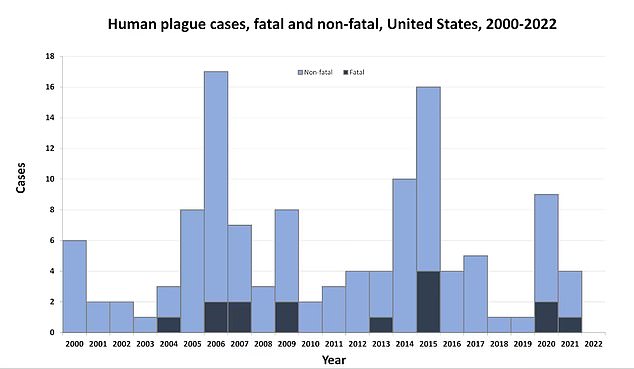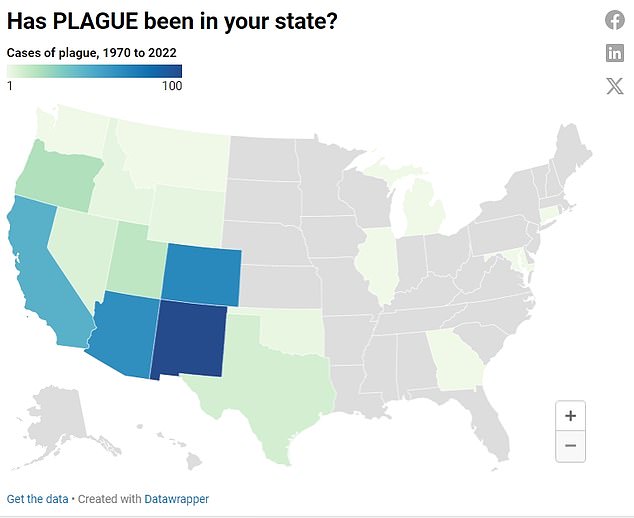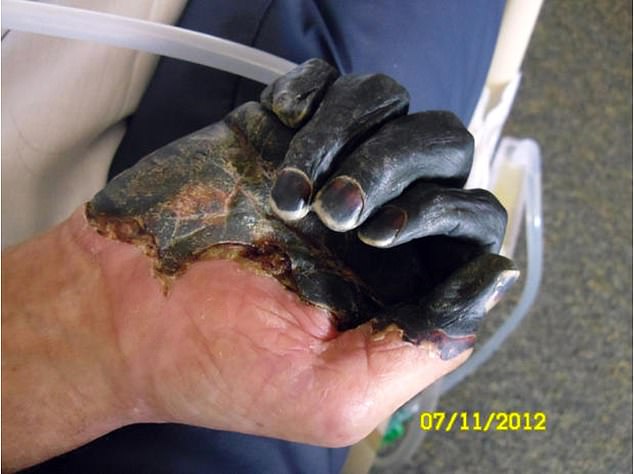An interactive map reveals the states where you can still contract one of the deadliest bacterial diseases in human history.
It comes as a case of bubonic plague in Colorado is gaining attention as many assumed the medieval disease was a thing of the past.
But official U.S. data show that 18 states have suffered outbreaks in the past 50 years, usually linked to contact with rodents or bites from infected fleas.
In total, there are about seven cases per year nationwide.
The blackened fingers seen above belong to a man who contracted the plague in 2012 in Oregon. He contracted it after being bitten by a cat.
Infections are primarily reported in the western U.S., with New Mexico and Colorado reporting the highest number of infections over the past 50 years.
However, there are also sporadic cases in the east of the country, although they are usually related to international travel or laboratory accidents.
There have been three cases so far this year, including a person in Oregon who was infected by his cat and a man in New Mexico who died from the disease.
Plague, which arrived in the United States in the 1900s, can be transmitted to people through contact with rodents or the bites of infected fleas or pets.
The most common type in the U.S. is bubonic plague, which triggers warning symptoms one to seven days after infection.
The other form, pneumonic plague (contracted by inhaling infected droplets), causes symptoms one to three days later.
Patients typically survive only a few days without treatment, with a mortality rate of up to 60 percent among patients linked to the sepsis that causes the disease.
But it can be easily diagnosed by a mucus test and then treated with antibiotics to eradicate the infection.
Plague is known as one of the deadliest bacterial infections in humans because it swept through Europe during the Middle Ages, killing 50 million people, or nearly a third of the continent’s population.

This chart shows recorded plague cases and deaths by year since 2000.
The CDC says there have been 500 cases of plague in the past five decades, from 1970 to 2022.
Three-fifths of these cases occurred in New Mexico alone, while Arizona and Colorado account for another fifth of infections.
California, Oregon and Utah have each recorded more than ten cases during this time, while Texas, Nevada, Idaho, Wyoming and Oklahoma have each recorded more than one.
The CDC says cases have been detected in everyone from infants to adults in their 90s, though they are most common among people ages 12 to 45.
Previous cases include a 10-year-old girl in Colorado who died from the disease in 2021, the first death in the state since 2015.
And a rare infection in a University of Chicago researcher working on plague in 2009. He is believed to have contracted it in a laboratory accident.
A 59-year-old man who survived the plague in Oregon in 2012 but had to have his fingers and toes amputated said he felt “lucky to be alive.”

The map above shows the states that have recorded cases of plague over the past 50 years.
Paul ‘Steve’ Gaylord became infected after trying to remove a mouse from the throat of a plague-stricken cat, which bit him.
He was treated with antibiotics but spent nearly a month on a ventilator and his family prepared for his death. He needed physical therapy after the infection and had to have his hands fitted with prosthetics.
Plague arrived in the United States in the 1900s by traveling on rodents on infested steamships.
It was prevalent in Western port cities for the next two decades and then spread to rural rats and mice, where it persists to this day.
The last major outbreak in a city was in Los Angeles in 1925.

